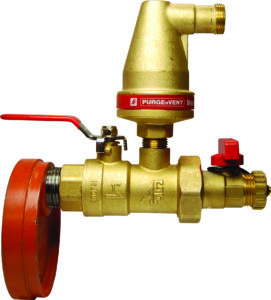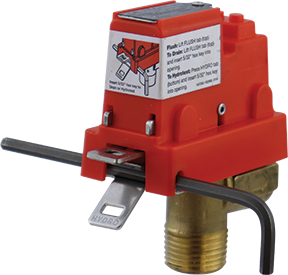As building designs become more compact and mechanical spaces become more congested, fire protection systems must adapt to fit tighter footprints without sacrificing reliability or code compliance. AGF’s Model 8611 Corner Riser is designed with this challenge in mind—offering a smarter, more space-efficient solution for floor control assemblies.
Steve Tajer Joins AGF Manufacturing as Regional Sales Manager – South
AGF Manufacturing proudly welcomes Steve Tajer as our new Regional Sales Manager for the Southern U.S.

With a territory covering Texas to the top of North Carolina, Steve will work closely with fire protection contractors, distributors, and industry partners to support AGF’s mission of delivering innovative, reliable solutions for the fire protection industry. He’ll focus on providing product knowledge, technical support, and strengthening relationships across the region.
Steve brings over a decade of experience in commercial construction, including nearly five years in fire protection sales. His hands-on industry knowledge and commitment to customer service make him a strong addition to the AGF team.
We’re excited to have Steve on board—please join us in welcoming him to AGF!
AGF Manufacturing Launches PURGENVENT™ Model 7940 BLE
A BABAA-Compliant Automatic Air Vent Assembly for Wet Fire Sprinkler Systems
Malvern, PA – April 14, 2025 — AGF Manufacturing proudly announces the release of the PURGENVENT™ Model 7940 BLE (Branch Line Extension), a Build America, Buy America Act (BABAA) compliant automatic air venting valve assembly designed to increase the longevity and reliability of wet pipe fire sprinkler systems. With integrated features for streamlined installation, system protection, and NFPA 13 compliance, the 7940 BLE sets a new standard for air management in fire protection.

“The 7940 BLE is a comprehensive solution to help contractors meet NFPA 13 code requirements while simplifying installation and improving long-term system performance,” said Jim McHugh, President of AGF Manufacturing. “It’s everything you need for compliant venting in one factory-assembled, American-made package.”
Continue reading AGF Manufacturing Launches PURGENVENT™ Model 7940 BLE →
AGF Welcomes George Stewart to the Engineering Team
Industry Veteran Brings Engineering Expertise to Support Product Innovation and Customer Solutions
 Malvern, PA — April 9, 2025 – AGF Manufacturing is pleased to announce the addition of George Stewart to its growing engineering team. George brings with him a wealth of engineering experience across a diverse range of industries and a strong track record of developing specialized equipment and systems.
Malvern, PA — April 9, 2025 – AGF Manufacturing is pleased to announce the addition of George Stewart to its growing engineering team. George brings with him a wealth of engineering experience across a diverse range of industries and a strong track record of developing specialized equipment and systems.
George began his career at Gamajet/Alfa Laval, where he worked his way up through the engineering department. There, he focused on designing advanced tank cleaning machines and systems used in a wide range of industrial applications. His career then took him to National Foam, where he specialized in high-flow and high-expansion foam firefighting systems, deepening his expertise in fire protection technologies.
Continue reading AGF Welcomes George Stewart to the Engineering Team →
Built in America: How AGF Supports U.S. Manufacturing and BABAA Compliance
AGF Manufacturing is a family-owned American manufacturer. It isn’t just a tagline—it’s a core part of who we are. 
For over 35 years, we’ve proudly engineered, manufactured, assembled, and shipped innovative fire sprinkler products all over the World, supporting American workers and delivering reliable solutions to contractors, engineers, and facility owners. Today, with growing emphasis on sourcing transparency and compliance with federal procurement rules, domestic manufacturing matters more than ever.
Navigating BABAA and Buy American Requirements
The Build America, Buy America Act (BABAA)—introduced as part of the 2021 Infrastructure Investment and Jobs Act—places stricter requirements on federally funded infrastructure projects. Specifically, BABAA mandates that all iron, steel, manufactured products, and construction materials used in these projects must be produced in the U.S.
Continue reading Built in America: How AGF Supports U.S. Manufacturing and BABAA Compliance →
AGF Manufacturing Welcomes Michael DiRezzie as National Sales Manager of Canada

AGF Manufacturing is excited to announce Michael DiRezzie’s addition as our new National Sales Manager of Canada. With over 20 years of sales management experience, Michael will be pivotal in expanding AGF’s presence across Canada.
Michael’s responsibilities will include educating contractors and distributors about AGF’s innovative product line and enhancing relationships throughout the industry. His extensive expertise and dedication to customer success make him an excellent fit for this role.
You can meet Michael at several upcoming events, including the Canadian Fire Safety Conference and Expo, CASA Annual Conference, and SFPE Annual Conference and Expo.
Please join us in welcoming Michael to the AGF team!
Why a Remote Inspector’s Test Valve is Not a Good Air Vent
Proper air venting is essential when designing and installing a wet pipe fire sprinkler system to reduce corrosion risks and ensure system performance. While NFPA 13 allows for different methods of venting air from a sprinkler system, including a manual valve, an automatic air vent, or a remote inspector’s test valve, it is crucial to understand why a remote inspector’s test valve is not an effective air venting solution.

Continue reading Why a Remote Inspector’s Test Valve is Not a Good Air Vent →
Air Vents for Wet Fire Sprinkler Systems: Understanding NFPA 13 Requirements
Air management is critical in wet fire sprinkler system design that utilizes  metallic pipe. Trapped air can contribute to corrosion, leading to costly maintenance and potential system failure. NFPA 13 recognizes this and mandates at least a single air vent on wet pipe fire sprinkler systems, but the code allows the system designer to determine if additional vents are necessary.
metallic pipe. Trapped air can contribute to corrosion, leading to costly maintenance and potential system failure. NFPA 13 recognizes this and mandates at least a single air vent on wet pipe fire sprinkler systems, but the code allows the system designer to determine if additional vents are necessary.
8.1.5.1 NFPA 13 (2019) – “Venting from multiple points on each system shall not be required.”
The NFPA 13 Code Requirement
NFPA 13 requires at least one air vent near a high point in the system to help exhaust air. However, the code does not specify a maximum number of vents, leaving it up to designers to assess whether additional vents are needed to remove air that causes corrosion. While some manufacturers design vents with redundant air vents or drip pans as a necessity, AGF Manufacturing provides a smarter solution with its innovative automatic air vent design.
Why Choose an Automatic Air Vent?
Continue reading Air Vents for Wet Fire Sprinkler Systems: Understanding NFPA 13 Requirements →
Prevent Freezing: Your Auxiliary Drains Need Drained NOW!
With cold weather coming, even southern areas that usually don’t freeze need to prepare their fire sprinkler systems. It’s important to take action now. For dry and pre-action sprinkler systems, one of the most common vulnerabilities during extreme cold is auxiliary drains. Neglecting to properly maintain and drain these components can lead to costly damage and system failure.
What Are Auxiliary Drains?
Auxiliary drains, called drum drips or low point drains, are important parts of dry and pre-action fire sprinkler systems. They collect condensation that forms inside pipes, preventing it from pooling and causing corrosion or blockages. When temperatures drop below freezing, water in the auxiliary drain can freeze. This ice can expand and may crack the drain or the system’s pipes.
Continue reading Prevent Freezing: Your Auxiliary Drains Need Drained NOW! →
How to Select the Correct PSI for your Fire Sprinkler Pressure Relief Valve
FAQ – Which PSI???
Pressure relief valves are critical components in fire sprinkler systems,

safeguarding the system by relieving excess pressure caused by supply surges or temperature fluctuations. Since the 2010 edition of NFPA 13, these valves have
been mandatory for all wet pipe systems. Selecting the correct pressure relief valve for a specific system requires careful planning to ensure compliance and optimal performance.
Understanding NFPA 13 Requirements
NFPA 13 outlines the necessity of pressure relief valves to maintain system integrity:
- Relief Valve Specifications: Wet pipe systems must include a listed relief valve of at least 1/2 inch in size. The valve should operate at either 175 psi or 10 psi above the maximum system pressure, whichever is greater.
- Listing Requirements: A “listed” valve must meet standards set by third-party organizations like UL or FM, ensuring the valve’s reliability and suitability for fire sprinkler systems.
- Exception Clause: Relief valves are not required if auxiliary air reservoirs are installed to absorb pressure increases.
Continue reading How to Select the Correct PSI for your Fire Sprinkler Pressure Relief Valve →

